Abstract: This paper is composed of three parts connected consecutively because their conclusions build upon each other. The first part investigates the transportation methods used in the Book of Mormon, concluding that horse and river travel contributed little and that foot travel dominated all journeying. The second part uses that conclusion to estimate the overall dimensions of the Promised Land by examining Alma the Elder’s journey from Nephi to Zarahemla. This exercise reaffirms the 200-by-500-mile size promoted by John L. Sorenson decades ago. The third part looks at four ramifications of this 100,000 square-mile Promised Land footprint when stamped upon a map of the Western Hemisphere. (1) It allows for more than one Promised Land (occupied by other God-led immigrants) to exist simultaneously in the Americas. (2) It predicts that no matter where the Book of Mormon Promised Land was originally located, most Native Americans today would have few or no direct ties to the Jaredites-Lehites-Mulekites. (3) It demonstrates that research efforts to identify evidence of the Book of Mormon peoples could be exploring locations thousands of miles away from their original settlements. And (4) If any of the post-400 ce localized population losses in the Americas due to disease, war, or unknown causes involved the original Promised Land location, then the primary locus of organic evidence of the existence of the Jaredite-Lehite-Mulekite populations might have been largely destroyed.
For almost 200 years, scholars have discussed three important geographical questions regarding the Book of Mormon’s Promised [Page 74]Land. The first question, “Where is the original location?” is still sometimes hotly debated.1 This article will not address this issue directly. The second, “Were indigenous populations present or absent on the arrival of the Jaredites, Lehites, and Mulekites (empty continent versus inhabited continent theories)?” has been largely resolved for most researchers, who acknowledge multiple Book of Mormon textual references that demonstrate the existence of preexisting populations.2 Similarly, the third question, “What does the Book of Mormon portray as the geographic size of the Promised Land (hemispheric versus limited geography theories)?” has been settled in favor of a limited geography as observers discard the idea that the Book of Mormon peoples inhabited the entire Western Hemisphere.
A fourth question, perhaps one that will remain controversial, asks What does the narrative say about the general dimensions of the limited geography? The first two parts of this paper focus on this question. Part I examines Book of Mormon transportation methods by addressing references to horses in the text, as well as theories that river travel may have predominated. After concluding that foot travel prevailed, Part II analyzes transit speeds for Alma the Elder’s journey from Nephi to Zarahemla to estimate that distance and then approximate the overall dimensions of the Promised Land. These results reaffirm John L. Sorenson’s geographic size of about 200 by 500 miles.3 Part III investigates several of the ramifications of a 100,000-square-mile Promised Land when that footprint is stamped on a map of North and South America.
[Page 75]Part I: Book of Mormon Transportation
The Book of Mormon contains hundreds of references to locations and journeys between those locations. It often states or implies relative travel times of a few days to a few weeks. No distances in the Promised Land require months or years to traverse.4 Estimating those distances demands an understanding of the transportation methods that were used. While modern overland transportation did not exist, foot traffic, water navigation, animal-drawn vehicles, and riding on mammals (like horses) were all possibilities.
Horses in the Book of Mormon
Undoubtedly, the most famous animal mentioned in the Book of Mormon is the horse, but not due to its indispensable contributions to societies in the unfolding saga. Instead, critics usually list it as their leading supposed anachronism and as primary evidence against the Book of Mormon’s historicity.5 For example, in his conclusion of An Imperfect Book: What the Book of Mormon Tells Us about Itself, Earl Wunderli wrote in 2013: “Throughout my study of the Book of Mormon, I have been surprised by the anachronisms [that] others before me have identified, including horses.”6 Such critiques consistently reflect presentism by assuming that horses in the Book of Mormon were Equus caballus, the common horse found throughout the world today.
Horse and Non-Horse Nations
Historical records predictably show that the presence or absence of Equus caballus affects the expansion of growing nations. “In the history of humankind there has never been an animal that has made a greater impact on societies than the horse,” explains horse historian Sandra Olsen.7 “Other animals were hunted much more or domesticated [Page 76]earlier, but the horse changed the world in innumerable ways with its tremendous swiftness. While asses, camels, elephants, yaks, and other animals were ridden by people, the horse provided the first source of ‘rapid transit.’”8 Ann Norton Greene explains other important reasons:
Horses are one of only fourteen large (over 100 pounds) domesticated animals in the world, the others being camels, llamas/alpacas, reindeer, yak, asses (donkeys), pigs, sheep, goats, and several kinds of cattle (including water buffalo). Only three of these — horses, donkeys, and cattle — are used worldwide. All of them share the same set of characteristics. All of them are large enough to be useful for work or food, but not too large to control. None are carnivores that might view humans as lunch. All are herd animals with stable, sociable dispositions, accustomed to living in hierarchical social groups and fitting comfortably into the hierarchy of human society. They breed easily in captivity and have gestation periods of less than a year. They have nicely balanced fight-flight instincts, neither too aggressive nor confrontational, nor flighty and inclined to panic and stampede.9
In 2009, Pita Kelekna published The Horse in Human History, where she spends most of her final chapter contrasting societies that evolved with and without Equus caballus, outlining specific differences in areas of agriculture, metallurgy, trade, dissemination of ideas and inventions, warfare, religion, language distribution, and colonial expansion:10 She observes: “It is almost as if there existed on the planet two experiments in human civilization — one horsed, the other horseless.”11 Her observations are summarized in Table 1.
[Page 77]Table 1. Comparison of characteristics of societies that evolve with and without Equus caballus.
| Horse Nations | Non-Horse Nations | |
|---|---|---|
| Agriculture | Horses were used for harrowing, plowing, planting, harvesting, and hauling. Equine could easily transport the heavy plow to fields in outlying areas not previously cultivated due to distances. The main asset was versatility. | Without domesticated work animals, sustaining large-scale agricultural projects across flatlands remained difficult. Most prairie lands remained agriculturally undeveloped and largely uninhabited. Mountain terraces with irrigation projects were typical. |
| Metallurgy | Horsepower allowed more distant mineral deposits to be surveyed and prospected. Equine increased the ease of moving metals and disseminating new metalworking techniques. Heavy coins could be easily transported. | Metallurgy was invented independently in centers isolated by just a few hundred miles. Little or no industrial communication and interstimulation existed between centers. All minerals were moved by human transport. |
| Trade | Horse-drawn vehicles were standard. Equus is unparalleled in the animal kingdom over long distances for speed, strength, and stamina. Rulers embarked on ambitious programs of road construction over thousands of kilometers to promote trade and establish dominance across many regions. | Commodities were traded in small loads on foot by human porters who averaged only 23 kg [51 lbs] per day over a distance of 21−28 km [13−17 miles]. Without rapid, high-volume overland trade capacity, there was no great stimulus for diverse maritime transportation. |
| Dissemination of ideas and inventions | Horse-drawn and horse-mounted messengers facilitated the conveyance of technologies like writing, mathematics, science, art, and calendaring. A society could share and exploit discoveries in distant regions more quickly through equine-enabled communications. | Diffusion of ideas and inventions, when it did occur, occurred less effectively, requiring more time. Commercial, religious, and entertainment centers were regionally delimited. |
| Warfare | Light-weight horse-drawn chariots designed for speed accompanied by horse-born riders allowed equestrian armies to advance up to 100 km [62 miles] a day. Armed equestrians in cavalry units quickly overwhelmed infantry. An experienced horse-mounted archer could shoot arrows from either side of a horse at full gallop.12 Riders could scout greater distances to learn of opposing forces and to identify suitable camping areas for large armies. | Foot armies could transport supplies for about an eight-day round trip. While arrows, spears, and stones lengthened a warrior’s effectiveness, battle efforts depended on human strength to transport and engage in combat. |
| [Page 78]Religion | The world’s most populous religions, Christianity, Islam, Hinduism, and Buddhism, emerged between 2000 bce and 1000 ce when equestrian empires were forged. These horse-spread religions today are represented on every continent in temples, churches, and mosques. | Great ceremonial temples were centers of sacred pilgrimage and were regionally delimited. Religious diffusion remained restricted by topographical distances. |
| Language Distribution | Horses enabled the evolution of large linguistic geographic blocs. With the help of horse transportation, Spanish, Portuguese, and English became the dominant language across the Americas after Europeans with their horses arrived in 1500 ce. | Although geographic isolation did not always involve great distances, adjacent regional languages could evolve into highly contrasting vernaculars, despite a common origin. |
| Colonial Expansion | Horses consistently represent ancient symbols of wealth, physical power, and social mastery, a marker of upward mobility and social status.13 Potent symbols of military might, cavalry, and artillery horses were vital in all programs of imperial expansion, including those with advanced maritime capabilities. The use of horses at least doubled the geographic range of patrols, at least quadrupling the area of potential dominance.14 | Travel speeds for foot soldiers, guards, and messengers diminished the ability of a sovereign to exercise direct control over an extensive territory. Expanding that dominion demanded increased decentralization of the political structure with the potential for destabilizing remote rebellions. |
The Book of Mormon Describes Non-Horse Nations
Kelekna’s findings can be applied to Book of Mormon civilizations to discern whether the Jaredites, Nephites, or Mulekites evolved with or without the services of Equus caballus. That is, her research can classify Book of Mormon peoples as horse nations or non-horse nations based on historical descriptions of the same topics she has identified.
Agriculture: More than sixty passages refer to agriculture in the Book of Mormon, but none mention the horse contributing.15 The Jaredites may have used a beast to pull a plow-like tool: “And they did make all manner of tools to till the earth, both to plow and to sow, to reap and to hoe, and also to thrash. And they did make all manner of tools with which they did work their beasts” (Ether 10:25–26). To “till” the “land” or “ground” is also repeatedly referenced, but none of the verses specifically describe a horse pulling a plow.
[Page 79]Transportation: Transportation in the Book of Mormon never explicitly involves horses. Author Orson Scott Card observes: “In the Book of Mormon, nobody rides anywhere. … People in Joseph Smith’s day rode everywhere they could — on either a horse or a wagon.”16 Likewise, for moving materials or products, “There is no question that the basic means for transporting goods in Mesoamerica has always been the human back,” notes John L. Sorenson. “No phrasing anywhere in the record indicates land transport other than on the backs of humans.”17 This appears to apply to transportation throughout North America during the Book of Mormon period. While llamas transported goods in areas of South America for centuries, they were too small to routinely transport adults.
Chariots: The Book of Mormon contains six references that associate horses with “chariots,” but one of them is mentioned only as part of a quoted Bible passage (2 Nephi 12:7). The Lamanite King Lamoni has horses and chariots and is later described as “journeying,” but whether it was on foot, by horse, or by chariot is not specified (Alma 20:8). Chariots with wheels are not described in the Book of Mormon. Wheeled effigies have been identified in the Americas, but as John L. Sorenson explains: “Scholars have long operated on the assumption that the wheel was unknown in ancient American technology. The Book of Mormon implicitly agrees.”18 So assuming Lamoni’s “chariots” had wheels may not be justified. One definition for chariot in the Oxford Dictionary specifies “a stately vehicle for the conveyance of people,” and “vehicle” is defined as a “receptacle in which anything is placed in order to be moved.”19 Wheels would assist in moving but are not implicit in the definitions.
Traveling Distances: The distances described in the Book of Mormon are always defined according to foot-travel speeds.20 This account and [Page 80]all other accounts describing journeying in the Book of Mormon fail to mention horses, wagons, carriages, or coaches, which would have vastly improved travel speeds and efficiency.21
Slow Communications: The slowness of communications in the Promised Land is consistent with foot travel (rather than the more rapid transmission of information via horse travel). This is demonstrated as Alma addresses “the awful dilemma that our brethren were in at Zarahemla” (Alma 7:3). He immediately declares repentance and puts the church in order there. Then, “When Alma had made these regulations he departed from them, yea, from the church which was in the city of Zarahemla, and went over upon the east of the river Sidon, into the valley of Gideon, there having been a city built, which was called the city of Gideon” (Alma 6:7). The journey does not seem far. The river Sidon was close to Zarahemla and the valley on the other side of the river. Whether it is ten miles, twenty, or even thirty, it seems a short distance. Alma discovers that the inhabitants of Gideon were “not in a state of so much unbelief as were your brethren” (Alma 7:6). Consequently, he reports: “I shall also have joy over you” (Alma 7:5). Although separated by a relatively short geographic distance, the perversions of the Zarahemla residents had apparently not traveled to the city of Gideon.
Warfare: The Book of Mormon references eighty-five instances of armed conflict.22 Many of the accounts contain detailed descriptions of operations, strategy, and military tactics. William J. Hamblin has identified many of the intricacies of wars discussed (in no particular order):
- prebattle war councils
- guerrilla warfare techniques
- communal bases of military loyalty
- patterns of flight after the battle
- weapons technology and typology
- divination before battle
- extensive scouting and spying
- the ideology of holy war
- seasonal patterns in warfare
- treatment of robbers as brigands
- [Page 81]military implications of geography and climate
- recruitment based on tribes and communities
- limited use of animal resources
- importance of plunder in warfare
- the use of only pre-gunpowder weapons
- ritual capture of kings
- fortifications
- ritual destruction of cities
- social and economic impact of warfare
- human sacrifice
- agricultural economic base
- treatment of prisoners
- laws of war
- disposal of the dead
- complex prebattle maneuvering
- centrality of war to the elite culture
- use of banners for mobilization and organization
- camp purity to gain divine assistance
- proper tactical role of missile and melee combat
- the military implications of changing demographic patterns
- the problems of supplying soldiers in times of war
- the importance of oaths of loyalty and surrender
- religious ritual behavior before, during, and after battle
- the fundamental interrelationship between war and religion23
Despite these types of described war details in the numerous battles, “no animal is ever mentioned as being used for military purposes … animals did not play a significant role in Book of Mormon warfare, either in battle or for transportation of war supplies.”24
Horsemeat: Another possible benefit of horses involves horsemeat. “Horses almost certainly were first domesticated for use as food animals, like cattle or pigs,” writes Sandra Olsen.25 Historically, many civilizations have included horsemeat in their diets, but not in recent millennia.
In temperate Eurasia … horsemeat was highly regarded and these tastes can be traced back a very long way. During the [Page 82]last great Ice Age horsemeat was a staple in the diet of Homo sapiens; it has now become clear how widespread and how longlasting was this dependence on horsemeat.26
Four verses in the Book of Mormon place horses with animals that might be used for food (1 Nephi 18:25, Enos 1:21, 3 Nephi 4:4; 6:1).
The preceding discussions identify many characteristics of nations possessing Equus caballus when compared to those that have progressed without it. From these observations, it appears that the horses mentioned in the Book of Mormon behaved and were treated different from Equus caballus. (For a complete listing of mentions of horses in the Book of Mormon, see Table 5, in the Appendix.) Kelekna’s research supports that the civilizations of the Jaredites, Nephites, and Mulekites were non-horse nations, despite a few references to horses within their narratives (see Table 2).
Table 2. Comparing Kelekna’s horse and non-horse nations to the Book of Mormon civilizations and Joseph Smith environment.
| Kelekna’s Horse Nations | Kelekna’s Non-Horse Nations | Book of Mormon Civilizations | Joseph Smith’s Environment | |
|---|---|---|---|---|
| “Horses” present | Yes | No | Yes | Yes |
| Swift transportation | Yes | No | No | Yes |
| Extra-Regional Distances | Yes | No | No | Yes |
| Military cavalry | Yes | No | No | Yes |
| Military chariots | Yes | No | No | No |
| Pulling “chariots” or wagons | Yes | No | Possibly | Yes |
| Pulling a plow | Yes | No | No | Yes |
| Used for food | Sometimes | No | Possibly | No |
Other evidence could be supportive. For example, Mesoamerica incorporated all sorts of animals into their art and iconography — jaguar, turtle, and snake — but the horse is not usually included. “Figures in art occasionally picture humans riding on animals, usually deer.”27 It is also true that Equus fossil remains have been found that may date to Book of Mormon times.28 However, current paleontological evidence does not [Page 83]support the wide use of Equus caballus in the Americas before the arrival of the Europeans circa 1600 ce.
What could explain the Book of Mormon references to horses that, apparently, did not behave like Equus caballus? Several explanations are possible.29 Perhaps those horses represent an inexact translation of a different animal with some horse characteristics. Ironically, the much-maligned tapir (Figure 1), which has been suggested as a possible Book of Mormon “horse,” is taxonomically related to the Equus caballus, both being in the Perissodactyla order.30 Historically the tapir has been domesticated but apparently not tamed, raising questions about whether it could be the Book of Mormon horse.31
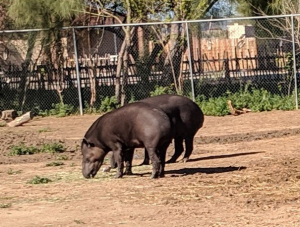
Figure 1. Tapirs foraging
A second possibility is that Equus caballus was present but proliferated poorly and disappeared sometime after Christ’s visit.32 A third explanation is that wild horses existed but were not widely domesticized to perform duties universally applied to horses in other civilizations (like transportation and warfare). This seems less likely, [Page 84]because, throughout history, societies consistently exploited their value in transportation and warfare when they were available. In summary, although the horse is mentioned in the Book of Mormon, multiple observations support that it was not Equus caballus, not an anachronism, did not contribute in any meaningful way to the transportation needs of the Promised Land’s populations, and most importantly, would not have facilitated the expansion of Book of Mormon territories as it had affected civilizations in the Old World.
A River Travel Theory
A relatively new theory promotes river travel as the predominant transportation method used by Book of Mormon peoples. It also assumes that watercraft on rivers could move people and supplies faster than on foot. Such assumptions portray river travel as providing the same advantages as horse travel, but without the need for Equus caballus. By facilitating rapid communication and interchanges between far-distant cities and lands, river travel ostensibly expanded the perimeter of the Promised Land well beyond the 100,000 square miles predicted by foot-travel-based estimates.
Jonathan Neville, a primary proponent of this theory, reports: “Ancient people always travel on rivers, and you can travel a lot farther on a river than you can through a jungle.”33 This theory posits that “the people in Nephi’s group would have been familiar with boats, yachts, canoes, and barges.34 As Neville explains, “people can travel faster by boat than by land; by boat, they can travel faster downstream than upstream.”35 According to this hypothesis, the Book of Mormon peoples preferentially chose faster river travel to foot travel throughout the Promised Land for hundreds of years. By actively using watercraft on rivers, the Nephites and Lamanites increased the geographic footprint of the Promised Land perhaps tenfold beyond the territorial boundaries projected by a non-horse civilization’s foot traffic.36
[Page 85]Challenges to the River Travel Theory
Undoubtedly the Book of Mormon populations employed some river travel. As John L. Sorenson explains, “Where a network of waterways allowed, fleets of canoes swarmed, carrying all kinds of goods as well as people. Most were simple dugouts that went only a short distance before the load was moved to another vessel.”37 Yet, several observations support that watercraft did not significantly affect Book of Mormon travel.
An obvious challenge is that rivers do not always go in the direction desired. Joseph Smith lived in a heavily rivered environment, but when his family moved from Sharon, Vermont, to New York, they went by wagon and on foot.38 When Joseph and his family traveled to Harmony, Pennsylvania, they went by buckboard. Their trips to find a printer in Rochester involved horseback and foot travel. Even with many rivers in the area, waterway excursions were less common because downstream currents did not arrive at the desired destination. Similarly, as the Saints crisscrossed the eastern United States from Western New York (and the hill Cumorah) to arrive in Nauvoo, Illinois, on the Mississippi River, some river travel supplemented the primary migration efforts, which were by horse, wagon, or on foot.
A second problem is the existence of fall lines, where an upland region meets a lower geological plain, creating elevation drops that produce waterfalls of varying heights. Even small drops could impede river travel in both directions. If blindly encountered while moving downstream, waterfalls could destroy watercraft and threaten the lives of travelers.39 To circumvent such obstacles, small rivercraft and their supplies needed to be transported by land around the falls. Larger riverboats require the construction of locks.
The third challenge, possibly the most important of all, involves the unalterable directionality of river travel. Going downstream is usually less arduous so long as the river is navigable without obstructive sandbars, rocks, debris, waterfalls, and other obstacles. In contrast, continuous traveling upriver, depending upon the flow and breadth of the current, is almost always more difficult than simply walking along a parallel trail or roadway. The advent of the steamboat in the early [Page 86]nineteenth century permitted captains to navigate larger waterways easily in either direction, but before their implementation, upstream travel often required immense human or animal energy.
Drawings from pre-steam-engine publications illustrate the four primary methods for moving a boat upstream.40 The most desirable involves setting sails and letting the wind move the boat forward into the current (see Figure 2). This requires a cooperative wind direction and a relatively straight river.
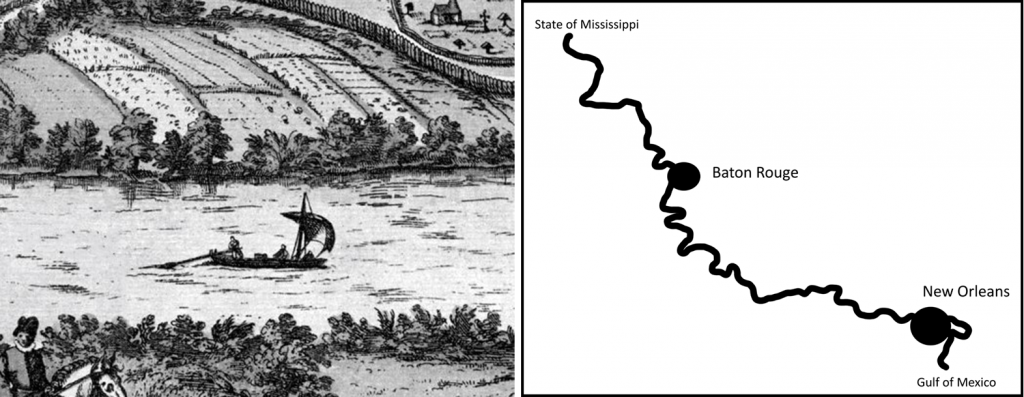
Figure 2. (Left) The ship raises its sail to take advantage of the breeze to propel the craft upstream. (Public domain.) (Right) The Mississippi River, as it flows through the state of Louisiana, shows its winding course. Wind direction could change rapidly, making sailing less efficient or even ineffective.
Amos Stoddard, in his 1812 book Sketches, Historical and Descriptive, of Louisiana, described some of the limits of sailing up the Mississippi:
Such is the rapidity of the current in the Mississippi, that no craft will be able to ascend it above Natchez [Mississippi] by means of sails only. Most of our boats make use of sails, when the wind is favorable; but this is merely occasional. Owing to the zig-zag course of the river … the wind is seldom favorable.41
Natchez is about 200 miles north of the Gulf of Mexico, nearly 600 miles south of St. Louis, and roughly 750 miles south of Nauvoo. If the challenges of Mississippi River travel in 1812 reflect those of previous centuries, ships destined for the St. Louis area could have sailed only [Page 87]about a third of the distance. Beyond that point, stronger propulsion methods would have been required.
A second approach, called “poling,” involves moving upstream by planting a pole in the river bottom alongside the boat and pushing forward into the current, as illustrated in Figure 3. In an 1810 book, Christian Schultz details how boatmen use their strength and long poles to impel the boat forward:
It is not often, however, that a fair wind will serve for more than three or four miles together, as the irregular course of the river renders its aid very precarious; their chief dependence, therefore, is upon their pike poles. These are generally from eighteen to twenty-two feet in length, having a sharp pointed iron, with a socket weighing ten or twelve pounds affixed to the lower end; the upper has a large knob, called a button, mounted upon it, so that the poleman may press upon it with his whole weight without endangering his person. This manner of impelling the boat forward is extremely laborious, and none but those who have been for some time accustomed to it can manage these poles with any kind of advantage. Within the boat on each side is fixed a plank running fore and aft, with a number of cross elects nailed upon it, for the purpose of giving the polemen a sure footing in hard poling. The men, after setting their poles against a rock, bank or bottom of the river, declining their heads very low, place the upper end or button against the back part of their right or left shoulders (according to the side on which they may be poling), then, falling down on their hands and toes, creep the whole length of the gang-boards, and send the boat forward with considerable speed.42
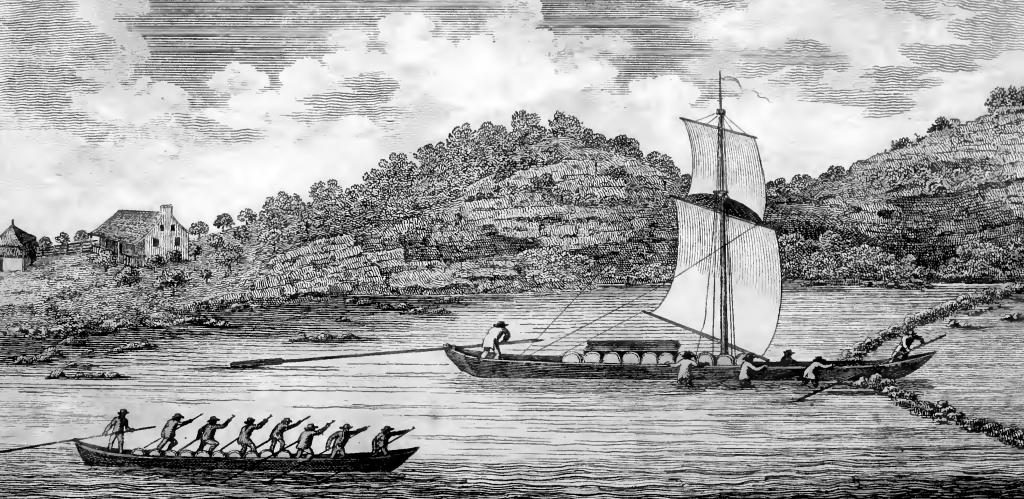
Figure 3. The boat to the left ascends the river with only poling efforts. The boat on the right uses sails, poling, and the strength of men in the water pushing. (Public domain)
[Page 88]The third method, shown in Figure 4, involves attaching a rope to the boat and pulling it forward by animals or men who walk in shallow water or along the shoreline. Sometimes, vegetative overgrowth or steep riverbank walls make this nearly impossible. Well-traveled waterways with sections of rapids could be traversed by hiring ox teams and their handlers along the shore to pull the ropes.

Figure 4. Both boats in the channel are being towed by animals on shore. (Public domain)
A fourth technique employs oars and rowing to propel the boat upstream at a rate faster than the downstream current. For slower-moving rivers, this may not be difficult. But as Ben Bachman, author of Upstream: A Voyage on the Connecticut River, reports, “There are pitches of current that can easily defeat paddlers far stronger than I.”43
A technique reserved for wider rivers involves crossing at an angle to zigzag up the stream against the current, as shown in Figure 5.
[Page 89]
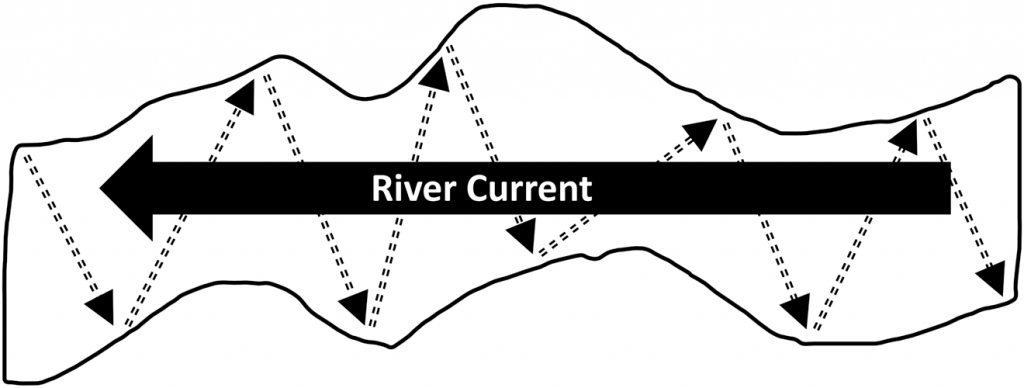
Figure 5. Travel upstream of wider rivers requires zigzagging across the channel. Rowing effort and distances are greatly increased
Cutting across the down-flowing water is necessary because rowers cannot generate enough speed to counter the rapid currents by heading into them directly and simultaneously driving the craft upstream. This method of upstream travel is evident in Figure 6.
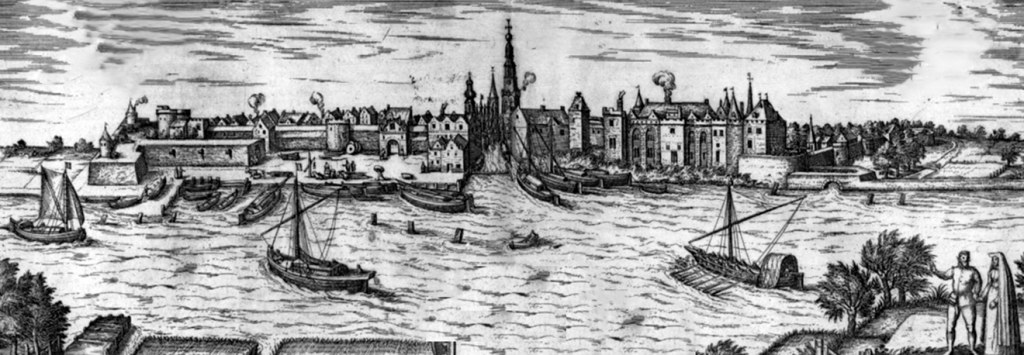
Figure 6. The boat on the right with multiple oarsmen rowing shows upstream travel at an angle to the downstream current. (Public domain)
Rowing Upstream on the Mississippi River
A 1796 publication commented on the difficulty of going up the Mississippi River: “In navigating that river we often find places like a horse-shoe, where we do not gain more than a mile by sailing or rowing five miles.”44 Amos Stoddard agreed: “The river is so winding, that the daily progress of boats to their destination, is very inconsiderable. In one instance they are obliged to stem the current for fifty four miles to gain five; in another thirty miles to gain one and a half.”45 Stoddard further explains:
[Page 90]Keel boats, however strongly manned, cannot possibly ascend to any great distance in the middle of the current; in some places, indeed, they cannot make head against it. They are obliged not only to ply along the shore, where the water is less rapid, and where counter currents or eddies frequently prevail, but they also find it necessary to keep on the side opposite to the bends. Hence they cross the river at the lower extremity of every bend, which can seldom be done without falling down with the current about half a mile. It is said by old boatmen, that they are obliged to cross the Mississippi three hundred and ninety times on ascending from New-Orleans to St. Louis.46
Stoddard noted that “one of our gun boats was about eighteen months in ascending from Natchez [Mississippi] to the Ohio [River],” a distance of over 350 miles.47 The Ohio River joins the Mississippi River about sixty miles downstream from St. Louis, Missouri.
Lewis and Clark
A classic example of river transportation is the Lewis and Clark expedition that “traveled 10,624 miles, 9,046 miles of it by river (5,498 miles downstream, 3,548 miles upstream) during a period of more than three years (August 31, 1803, through September 23, 1806).”48 Forty-four men and one woman, translator Sacagawea, boarded a keelboat and several smaller watercraft at St. Louis to ascend the Missouri River. Historian Verne Huser describes their primary vessel:
The keelboat was fifty-five feet long and eight feet wide. … It was equipped for four means of propulsion: a large square sail for sailing, twenty-two oars and thole pins “to row by,” a supply of push poles for poling or pushing, and several ropes for towing. It could be sailed when the wind was right; rowed by a large crew of strong men; poled by a coordinated team; or towed by oxen, horses, or men. … Traveling upstream against a four- or five-mile-an-hour current is hard work, whatever method is used.49
[Page 91]Each of the “four means of propulsion required significant human strength to implement.” Huser further declared: “The crew members often served as beasts of burden; traveling down the Ohio on low water, they literally had to lift the boat over shoals on numerous occasions.”50 Huser concludes: “Even though rivers were highways in the days of Lewis and Clark, they were often undependable.”51
The Book of Mormon Describes No River Travel
The Book of Mormon’s references to rivers and transportation methods represent another challenge to the theory that river travel was common or popular among the Jaredites, Lehites, and Mulekites. The words “river” or “rivers” are referenced 47 times in the Book of Mormon, but riverboats or river migrations are never mentioned. Jonathan Neville explains that this is because the prophet-scribe Mormon states that he could not write “a hundredth part” of “their shipping and their building of ships” (Helaman 3:14).52 A ship is, by definition a “large sea-going vessel (opposed to a boat).”53 The only ships mentioned in the Book of Mormon are those traveling by sea, not in rivers. Nephi builds a ship large enough to carry the Lehites to the Promised Land (1 Nephi 18:2, 8), and Hagoth built ships that were launched into the west sea (Alma 63:5).
Another problem is that the verbs commonly used in the Book of Mormon to describe human transit are often limited to foot travel: march (82), wander (17), drive (99), flee (68), pursue (42), and scattered (73). In contrast, words that might describe water travel between cities in the Promised Land — like float, glide, row, waft, sail, cruise, voyage, or paddle — are absent.54 Neither are additional references found to river craft design, construction, usage, and benefits (especially in wartimes). Attributing such silences to a declaration by Mormon that shipping was not going to be mentioned seems inadequate.
In addition, the Book of Mormon describes 149 distinct geographic locations that are referenced 670 times. Only eleven are described as being near a river: the land of Zarahemla, city of Zarahemla, hill Amnihu, [Page 92]valley of Gideon, city of Gideon, land of Melek, borders of Manti, land of Manti, hill Riplah, land of Cumorah, and hill Cumorah.55
If river travel in the Book of Mormon were important enough to significantly expand the dimensions of the Promised Land, perhaps ten times or more, readers must accept several assumptions. First, more cities were located near rivers than the text describes. Second, a crucial boating and travel industry existed that the text treats with complete silence. Third, river commuters developed effective upstream travel techniques, all of which demanded significant time and human energy, to consistently convince travelers to abandon walking along trails parallel to the river. And fourth, that transportation between cities not connected by a river was also expedited through an undescribed process to be more rapid than foot travel. Reviewers unwilling to accept the assumptions will likely conclude that river travel did not enable Book of Mormon travelers to journey at speeds fast enough to greatly expand the Promised Land’s geographic boundaries.
Part II: Estimating the Size of the Promised Land
Accepting that foot travel was essentially the only form of transportation in the Book of Mormon allows the estimation of distances by using descriptions of transit times. For example, “It was only the distance of a day and a half’s journey for a Nephite, on the line Bountiful and the land Desolation, from the east to the west sea” (Alma 22:32). While the exact mileage a Nephite could travel by foot in a day and a half is not known, a range of probable distances can be accepted. In contrast, the distances a horserider or a boat moving downstream could travel for a day and a half would be much greater, but these do not apply to the Promised Land. Fortunately, the Book of Mormon describes the number of days needed to travel between two major metropolitan centers, the city of Nephi, located at the southern end, and the land of Zarahemla, located close to the center of the Promised Land.
The Distance Between the Cities of Nephi and Zarahemla
The book of Mosiah describes the number of days required for Alma the Elder and his people to traverse the terrain between Nephi and Zarahemla. The account includes many essential details regarding the travelers, the supplies they carried, and the accompanying animals:
- [Page 93]About 145 bce, Alma gathers believers in the place of Mormon, outside of the city of Nephi (Mosiah 9:8).
- King Noah sends an army to destroy them (Mosiah 18:33).
- Alma and his followers depart into the wilderness with their families, tents, flocks, and grain (Mosiah 18:34; 23:1).
- Noah’s army returns, having searched in vain (Mosiah 19:1).
- Alma’s followers include 450 men, women, and children (Mosiah 18:35).
- They travel eight days and settle in the land of Helam (Mosiah 23:3, 19).
- Alma’s people build a city and multiply and prosper exceedingly (Mosiah 23:5, 20).
- About 120 bce, a Lamanite army arrives and subjects Alma’s people to bondage (Mosiah 23:25).
- God promises he will deliver Alma and his people from bondage (Mosiah 24:17).
- Alma and his followers spend the night gathering their flocks and grain (Mosiah 24:18).
- God causes a deep sleep to come upon the Lamanites (Mosiah 24:19).
- Alma and his followers travel one day and camp in a valley (Mosiah 24:18, 20).
- God tells Alma to leave, and he will stop the Lamanites in that valley (Mosiah 24:23).
- They travel twelve days and arrive in the land of Zarahemla (Mosiah 24:25).
- In the land of Zarahemla, King Mosiah receives them with joy (Mosiah 24:25).
These verses describe the travel time from the place of Mormon to the land of Zarahemla as twenty-one days.56 The distance from Nephi to the place of Mormon is unaccounted for, perhaps adding one more day. Twenty-two days of travel seems a reliable approximation.
The question is, how fast could Alma and his followers have made the entire journey? Some authors allege that this group could travel [Page 94]at speeds of three to four miles per hour for ten-to-twelve hours a day or traverse a span of up to 1,000 miles in a twenty-two-day trek.57 Yet, theories promoting these scenarios provide few details. Travel without animal-drawn wagons, horses to ride, or hundreds of canoes and a handy downstream river current leading to their destination suggests that transit speeds can be estimated by examining the travel capabilities and limitations of the group.
Travelers’ demographics: The first group of 450 (Mosiah 18:35) at the place of Mormon would have likely doubled in number in the twenty-five years, for they did “multiply and prosper exceedingly” (Mosiah 23:5, 20) in the Land of Helam.58 With families including men, women, and children, some elderly and toddlers would probably have journeyed at slower paces, as indicated in Table 3. Babies would have been carried.
Table 3. Human foot travel speed estimates.
| Foot Travel Speed | |
|---|---|
| Adult | 2−4 mph |
| Adult with pack | 2−3 mph |
| Children (across flat ground) | 1−1.25 mph |
| Children (hiking up elevations) | <1 mph |
| Toddlers and babies | [Carried] |
| Elderly (healthy) | 2−3 mph |
| Elderly (unhealthy) | ? |
| Disabled | ? |
Fleeing with armies in pursuit: With destroying armies in hot pursuit, Alma and his followers would have initially fled as quickly as possible. However, fears of being overtaken would have diminished after the second day because Noah’s armies immediately returned, and God stopped the Lamanites through an undisclosed means.
Stamina and fitness: Undoubtedly, many in the group were used to the hard physical labor of farming and living a subsistence lifestyle. But traveling for a mile or two is different from sustaining a longer migration of over ten miles a day for multiple days. The group’s overall progress would have been paced by the least fit of the travelers. The young children, the elderly, the sick, and the impaired would determine their daily progress, or they would have been carried or left behind. The need [Page 95]to rest and eat would slow the advancement, as would hunting for water or additional food if needed.
Packing grain and supplies: Both groups carried their “grain” with them as they moved along, presumably quantities needed for a journey of an underminable length. Without pack animals or wheeled conveyances, these burdens would have decreased travel performance.
Terrain and trail condition: Additional time would have been required if the groups encountered poor trail conditions and changes in elevation. Each entered the “wilderness,” which was so labeled for characteristics that probably would have made travel more difficult.
Weather conditions: The trekkers might have enjoyed ideal traveling conditions throughout the journey. Alternatively, snow, rain, and other inclement weather would have slowed the march, making the trail slippery and possibly more dangerous. Strong winds could affect balance problems for individuals carrying heavy packs (of grain). Extreme temperatures or humidity could demand more stops for hydration, warming, or rest.
Herding flocks: Having been warned to leave the next day, Alma’s people at Helam “gathered their flocks together … even all the night-time were they gathering the flocks together” (Mosiah 24:18). The need to gather flocks through the night could be due to a large number of animals, or to their scattered locations at the time, or both. The specific animals are not mentioned, but turkeys are indigenous to the Americas and might serve as an example. For example, turkey farmers Marvin and Eva Lee Sumner observe that “turkeys, unlike chickens, can be rounded up in flocks and driven.” But they warn,
One hazard of herding is the stampede. A turkey stampede sounds funny, but is no joke. As with steers, a turkey stampede is a blind rush away from danger. What danger? Who knows? A goblin scares one turkey. Every other turkey says, “I’m scared too!” Off they go. Turkeys spook easiest on moonlit nights. All that the herder can safely do is lie still and cover up. Two thousand birds, each a bundle of ten or twenty scared pounds, flying blind in the dark, can knock down almost anything they hit if it isn’t tied.59
Even without identifying the type or number of faunae in the flocks, several factors suggest that a sustained, rapid drive might have been [Page 96]difficult. “Too much driving pressure on the flock will result in some individuals reacting in panic and seeking an escape route by themselves.”60 Flocks not accustomed to sustained overland travel in a specific direction from morning until evening continuously for up to three weeks would probably not have been speedy or easily driven.
Group Travel
Examining the average daily speeds of other traveling groups in history (Table 4) might help estimate how far Alma and his followers journeyed during their twenty-two days in the wilderness.61
Table 4. Daily transit distances for various types of travelers.
| Daily Travel Averages | Comments | |
|---|---|---|
| Driving a herd of pigs62 | 11 miles | Many similarities to driving the flocks mentioned by Alma. |
| Handcart companies | 13.5 miles | Wheeled carts carried provisions. |
| Lewis and Clark | 14 miles | 44 men and one woman. No flocks. |
| Pioneer wagon trains | 15 miles | Used oxen and horse-drawn wagons. |
| Mormon Battalion | 15‒20 miles | Over 500 men, dozens of women and children. Wagons, mules. |
|
Zion’s Camp (Camp of Israel) |
19.1 miles | 90% of the group were men who marched, rode horses, and rode in horse-drawn wagons. No flocks. |
| 1884 cattle drive63 | 20 miles | Cowhands on horses herded the stock. |
[Page 97]While the data set in Table 4 is not extensive, it supports a land-travel range of 242 to 440 miles for the entire trip. Also, the faster groups all benefited from one or more of the following: horses, wagons or carts, male dominance, and a lack of flocks. Since Alma’s groups would have been limited in their speed by their slowest traveler — whether a child, elderly person, or animal — the lower number may actually be optimistic. Also, the number of miles traveled would have been more than the direct mapped distance between the two cities of perhaps 180 miles.
Identifying the 180-mile distance (as the crow flies) between Nephi and Zarahemla is helpful because Zarahemla is described as being in the “heart of their lands” (Helaman 1:18). But as John L. Sorenson points out, “the city of Zarahemla might be somewhat south of the land’s geographical center.”64 Doubling the Nephi-to-Zarahemla distance of 180 miles and adding additional space to the north for settlements could provide a workable estimate of the longitudinal dimension of the Promised Land.
In his book Mormon’s Map, John L. Sorenson, while examining the descriptions of movement across the Book of Mormon lands, concludes: “The promised land in which the Nephites history played out was on the order of five hundred miles long and over two hundred miles wide, according to Mormon’s mental map.”65 This constitutes a footprint of 100,000 square miles (see Figure 7). Critic Earl Wunderli agrees: “Sorenson’s construction of a limited geography based on the clues he uses is not unreasonable … Sorenson’s calculations are not unreasonable.”66
In summary, if Equus caballus and river travel did not affect transportation in the Book of Mormon, the population was restricted to foot travel. Estimating travel distances that foot traffic would permit according to the time intervals described in the text supports that the interactions of the Promised Land inhabitants extended through an area of approximately 100,000 square miles. Skeptics may understandably question the accuracy of any estimate, but accepting that the events occurred and that travel distances were accurately described should allow useful calculations to be made.
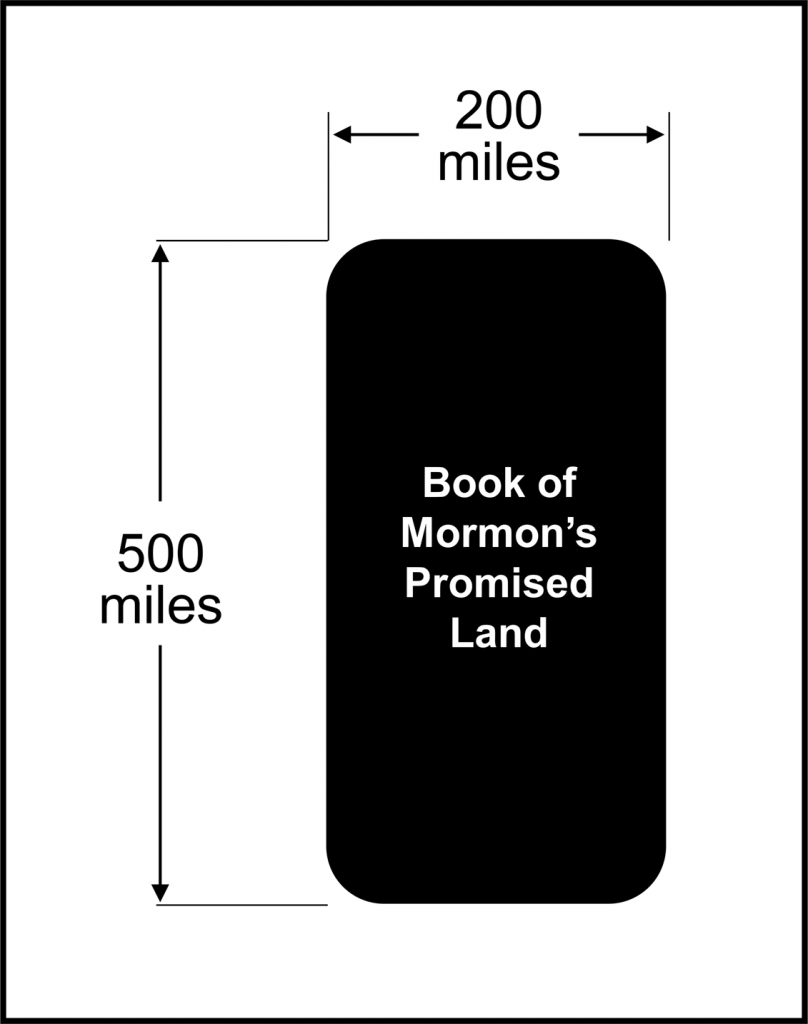
Figure 7. Regardless of the actual topographical shape of the Promised Land, the dimensions, calculated from foot-travel distances, would be approximately 200 by 500 miles
Part III: Possible Ramifications of a 100,000 Square Mile Promised Land
Part III now attempts to place the 100,000 square mile footprint of the Book of Mormon on a map of the Western Hemisphere. A territory of roughly 200 miles by 500 miles is little smaller than Ecuador or a little bigger than the state of Wyoming. Also, it should be understood that the influence of the Promised Land inhabitants undoubtedly spread beyond its geographic borders. Hagoth sent ships northward via the sea (Alma 63:5−7), land migrations occurred to the north (Helaman 3:3; Alma 50:11), and Nephite missionary efforts reveal the presence of other peoples not described in detail in the Book of Mormon (Alma 21:11, 31:37; 3 Nephi 9:10). Despite these probable expansions, observers willing to accept that the primary focus of Promised Land activities occurred in approximately 100,000 square miles can next explore some of its possible ramifications. While none of these ideas may be new, the remainder of this article examines their apparent implications for current interpretations and future research.
More than One Promised Land Could have Existed
Over the past decades, multiple sites attempting to identify an on-the-ground site for the Book of Mormon’s Promised Land have been [Page 99]promoted.67 Plausible theories must account for four variables: location, size, shape, and topographical features. To date, The Church of Jesus Christ of Latter-day Saints has refrained from assigning a specific physical location as the setting for the Book of Mormon.68 Regardless, acknowledging that the Promised Land inhabitants occupied a space of about 200 by 500 miles provides a visual context for placement somewhere in the Americas. Dozens of theories have advanced different locations throughout the hemisphere, as Figure 8 shows.
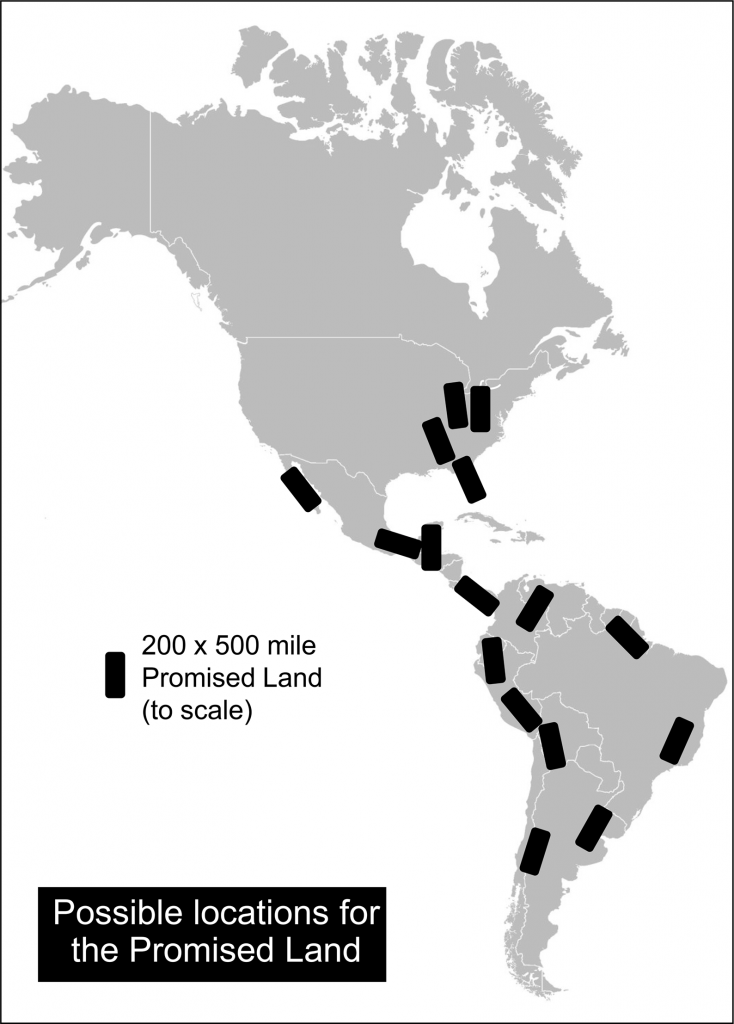
Figure 8. This illustration places a scale model of the Promised Land over locations promoted in the past
To be credible, theories in the future that describe the Book of Mormon peoples traversing much smaller or larger territorial boundaries need to [Page 100]defend their chosen locations, as well as the dimensions they promote. Irrespective of its actual location, an area of 200 by 500 miles occupies a very small portion of the available landmass. A 100,000 square miles area constitutes 0.6% of the Western Hemisphere (16,428,000 square miles), 1.5% of South America (6,888,000 square miles), 1.0% of North America (9,540,000 square miles), or 51% of Central America (196,000 square miles).69 It appears that the Jaredites, Lehites, and Mulekites existed in a very small portion of North or South America. If they had occupied Central America, they would have dominated much of the landscape but would have left North and South America essentially unexplored.
Archaeologists have shown that long-distance trading occurred throughout the Americas anciently, probably through sequential exchanges, usually of smaller, higher-valued goods, resulting in their transport across multiple societies into more distant territories.70 It is also true that small city-states in the past have exerted far-reaching influence and dominance through their armies and by sharing superior locally developed technologies. However, living without horses and rapid means of communication would have impeded widespread contact, extended dominion, or far-reaching influence. The prophets who engraved on the Nephite plates consistently relate a delimited, non-hemispheric, geographic zone where the events took place. They describe only local wars between cities that could be marched to in a matter of days. While the Book of Mormon peoples undoubtedly possessed some awareness of other populations outside their Promised Land, as far as the text is concerned, incidents occurring just a few hundred miles away transpired without their overall concern.
In light of the geographic limitations of the Book of Mormon world, a 100,000-square-mile Promised Land admits the possibility of other peoples (in their own Promised Lands) being led to the Americas by God besides the Lehites, Mulekites, and Jaredites. Several passages seem to support this possibility. Lehi instructed, “The Lord hath covenanted this land unto me, and to my children forever, and also all those who should be led out of other countries by the hand of the Lord” (2 Nephi 1:5).
[Page 101]Concerning the lost tribes of Israel, Nephi recorded, “The more part of all the tribes have been led away; and they are scattered to and fro upon the isles of the sea” (1 Nephi 22:4). And he quotes the Lord:
For I command all men, both in the east and in the west, and in the north, and in the south, and in the islands of the sea, that they shall write the words which I speak unto them. … I shall also speak unto the other tribes of the house of Israel, which I have led away, and they shall write it; and I shall also speak unto all nations of the earth and they shall write it. (2 Nephi 29:11–12)
The only known records today are those of the Lehites and Palestinian Israelites.
When speaking to the Nephites, Christ related, “I have other sheep, which are not of this land, neither of the land of Jerusalem. … But I have received a commandment of the Father that I shall go unto them, and that they shall hear my voice, and shall be numbered among my sheep” (3 Nephi 16:1, 3). Whether Jesus considered the Nephite “land” to be similar in size to the “land of Jerusalem” or much larger is unclear. The whole of ancient Israel spanned about 8,000 square miles. Still, even if “land” meant ten times that size, there would have been plenty of space for some of Christ’s “other sheep” to have existed elsewhere on the American continents, unknown to Book of Mormon scribes.
Perhaps in past millennia, God led members of the house of Israel to the heartland of North America, another group to present-day Peru, and still others to Mesoamerica or the Mexican Baja, with the Book of Mormon describing only one of these groups. If such groups had been divinely guided, it is conceivable that each migration party would have remained unaware of the other (Figure 9), especially if believers in each group were eventually destroyed by unbelievers. Likewise, as remnants of the House of Israel, each group would have infused additional blood of God’s chosen people among the inhabitants of the American Continents.
[Page 102]
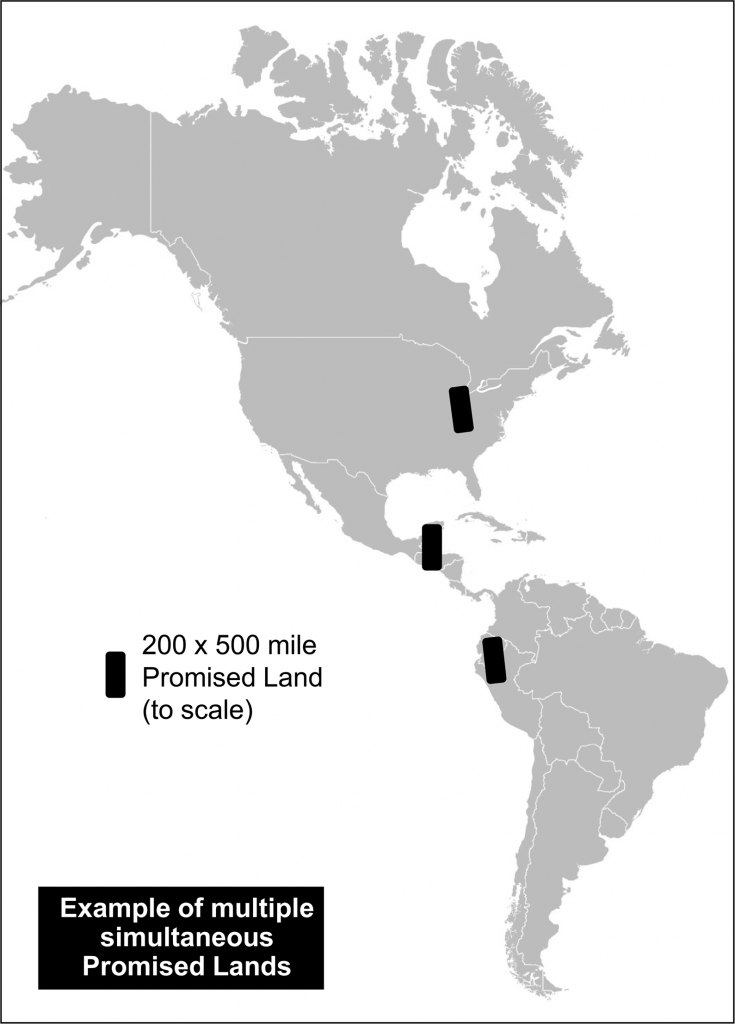
Figure 9. An example of how multiple Promised Lands might have existed without the other righteous groups being aware
Two Book of Mormon “Promised Lands”: One Limited and the Other Hemispheric
Independent of the observation that multiple Promised Lands might have simultaneously existed in the Americas is the realization that the Book of Mormon refers to two Promised Lands of differing sizes. Besides the 100,000 square mile Promised Land, a continental or hemispheric version is alluded to in Nephi’s visionary view of Columbus as “he went forth upon the many waters, even unto the seed of my brethren, who were in the promised land” (1 Nephi 13:12). Since Columbus’s multiple voyages ended in the Caribean islands and along the coasts of the Gulf of Mexico, they spanned more than 100,000 square miles. Likewise, his landings do not correlate to the topography described by Book of Mormon settlers. Nephi also saw how the European “Gentiles” would be led to “the land that the Lord God hath covenanted with thy father that [Page 103]his seed should have for the land of their inheritance” (1 Nephi 13:30). There, the gold plates would “be hid up, to come forth unto the Gentiles” (1 Nephi 13:35), which translation and publication occurred in upstate New York, thousands of miles from Columbus’s Promised Land contacts.
While the Book of Mormon does not define the specific borders of the larger Promised Land, Joseph Smith clarified: “The Book of Mormon is a record of the forefathers of our western Tribes of Indians … By it we learn that our western tribes of Indians are descendants from that Joseph which was sold into Egypt, and that the land of America is a promised land unto them.”71 By “land of America,” he later explained he meant the combined areas of the North and South American continents.72 So it appears that the narratives of the Jaredites, Lehites, and Mulekites occurred in what might be called the limited Promised Land of about 100,000 square miles. This area was actually part of what might be called the hemispheric Promised Land comprising 16,400,000 million square miles of the whole Western Hemisphere.
This differentiation is important, because a few decades after the death of the last Nephite believer (about 500 ce), three things occurred:
- The Nephite religious teachings that included a 100,000-square-mile Promised Land disappeared from the collective memory of the remaining inhabitants of that territory.73
- For all practical purposes, the limited Promised Land ceased to exist.74 This is attested to by the fact that we do not know its geographic location today.
- [Page 104]A hemispheric Promised Land would dominate modern references, without differentiating it from the the Book of Mormon limited Promised Land. For example, Joseph Smith taught, “Zion to be built upon this continent: for this is a promised land to the tribe of Joseph,” and “The whole of North and South America is Zion.”75
In summary, two Book of Mormon Promised Lands of differing sizes are mentioned. A limited Promised Land where the Book of Mormon narrative occurred with the Jaredites, Lehites, and Mulekites. Realistically, it ceased to exist when it faded from the recollections of the residents in that area sometime after 421 ce. References after that time imply a hemispheric Promised Land (see Figure 10).
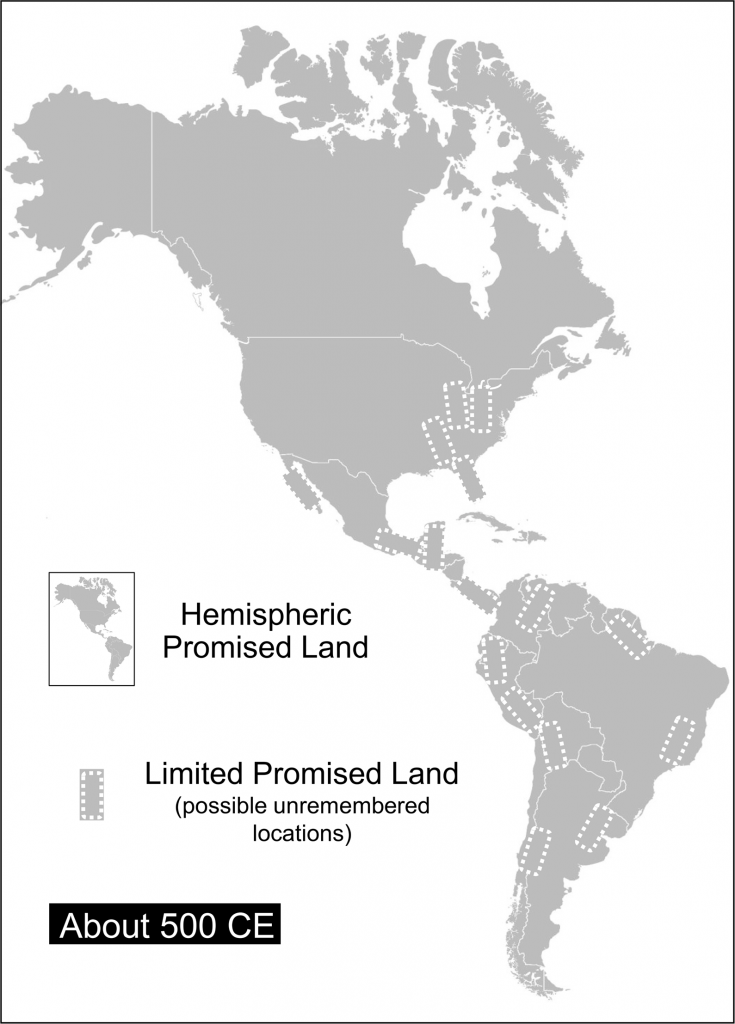
Figure 10. As the Book of Mormon Promised Land was forgotten about 500 ce, the only remaining Promised Land was hemispheric
Evolving Definitions from Original Lamanites to Modern Lamanites
Recognizing the existence of two Promised Lands of differing sizes affects the definition of “Lamanites” today. Technically, the first Lamanites in the Promised Land would have been Laman and his offspring, but that definition, if ever considered by any of the Lehites, was short-lived. Tracing the evolution of the term throughout the rest of the Book of Mormon and beyond provides insights regarding the expected relationship today between Native Americans and the Book of Mormon Lamanites.76
[Page 105]570 to 87 bce — Ideological Differences Separate Lamanites and Nephites
About 570 bce, Nephi first used the term “Lamanite” to describe Laman and all his followers who tried to destroy Nephi and his people (2 Nephi 5:14). A few years later, Nephi’s brother Jacob further clarified the dichotomy: “I shall call them Lamanites that seek to destroy the people of Nephi, and those who are friendly to Nephi I shall call Nephites,” (Jacob 1:13–14). Jumping ahead to 87 bce, the Book of Mormon writers continued to divide Nephites from Lamanites based upon their beliefs, not bloodlines: “Whosoever suffered himself to be led away by the Lamanites was called under that head” (Alma 3:10). Those living outside the Promised Land are not acknowledged in the descriptions.
[Page 106]36 ce — No Manner of “-ites”
After the coming of Christ about 36 ce, the Book of Mormon describes how the Promised Land inhabitants united to create a society that was without “Lamanites, nor any manner of -ites; but they were in one, the children of Christ” (4 Nephi 1:17). The geographic boundaries of the “children of Christ” during the next two centuries are not specified, but probably extended to the limits of the knowledge of the prophet-scribes chronicling those years, probably the borders of the 100,000-square-mile Promised Land. Consistent with previous Nephite accounts, indigenous peoples living beyond the believers’ settlements were left unidentified in the narrative, as illustrated in Figure 11.
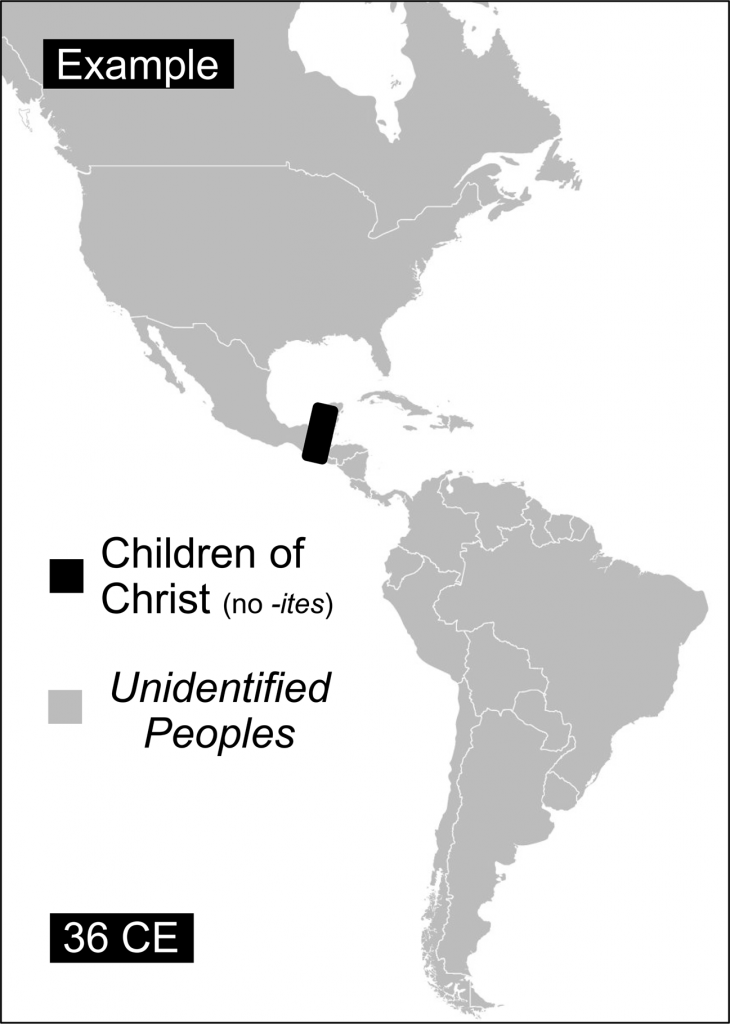
Figure 11. Using Central America as an example, by 36 ce, the residents of the Promised Land were united as the children of Christ without divisions or any “-ties.” People living outside that region were not mentioned
[Page 107]231 ce — “They Who Rejected the Gospel are Lamanites”
By 185 ce, “a small part of the people who had revolted from the church [took] upon them the name of Lamanites” (4 Nephi 1:20). The division is described as socio-religious and unrelated to genetics, race, or ethnicity.77 The rivalry continued until, by 231 ce,
there was a great division among the people. And it came to pass that in this year there arose a people who were called the Nephites, and they were true believers in Christ … And it came to pass that they who rejected the gospel were called Lamanites. (4 Nephi 1:35−36, 38)
By labeling all unbelievers as Lamanites, indigenous inhabitants inside and outside of the Promised Land were included because of their ignorance of Christ, as Figure 12 shows.
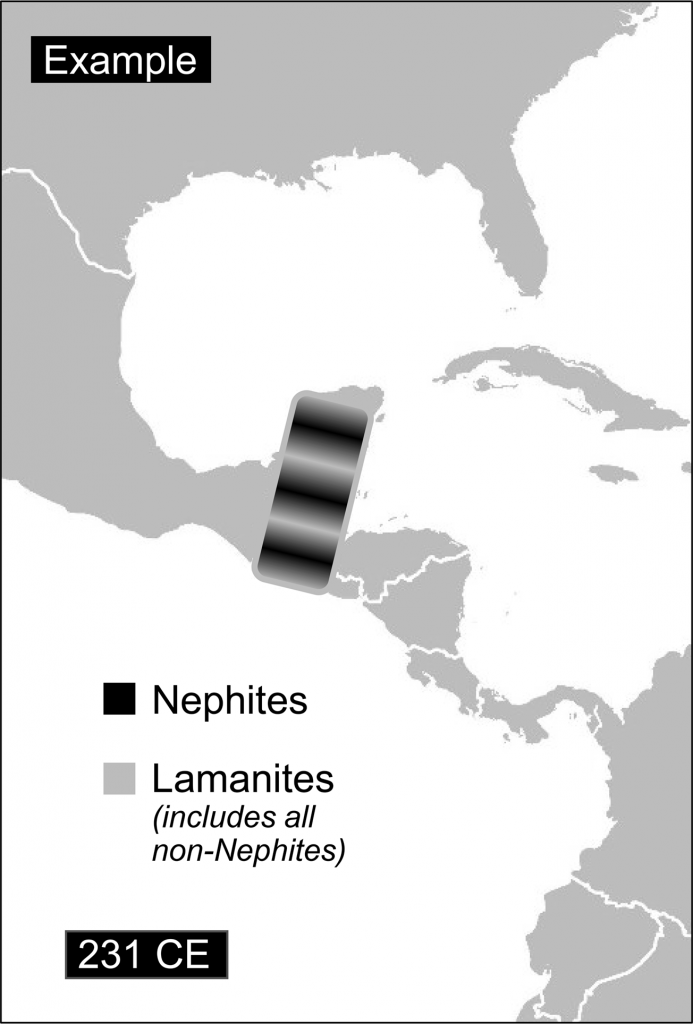
Figure 12. If the Promised Land, for example, was in Mesoamerica, the diagram shows that by 231 ce, a division occurred, with believers in Christ being Nephites and all surrounding unbelievers designated as Lamanites
400‒421 ce — Final Conflict Between the Nephites and Lamanites
The Nephite-Lamanite struggle expanded throughout the third and fourth centuries until armed combat resulted in the annihilation of all Nephite believers. As discussed above, this final conflict was not between
- The literal descendants of Nephi and the literal descendants of Laman.
- The righteous and the wicked.
- People with light-colored skin and people with dark-colored skin.
The final Nephite-Lamanite conflict was a civil war between two unrighteous populations, with a common religious tradition introduced by Jesus Christ in 36 ce. Their primary difference was that one arose as an anti-Christian movement around 185 ce and the other progressively rejected Christ and the prophets over the next two centuries.
[Page 108]Mormon describes how by 260 ce, “the people who were called the people of Nephi began to be proud in their hearts, because of their exceeding riches, and become vain like unto their brethren, the Lamanites” and just a few decades after that, “both the people of Nephi and the Lamanites had become exceedingly wicked one like unto another” (4 Nephi 1:43, 45). As Armand Mauss observed, about 400 ce “the Nephite and Lamanite antagonists were distinguished only by their differential spiritual condition rather than by skin color or other [Page 109]‘racial’ characteristics.”78 Elizabeth Fenton agrees: “The Lamanites’ story begins, but does not end, with racial delineation.”79
In the opening chapters of the Book of Mormon, before Nephites and Lamanites existed, Nephi describes the final battles in vision: “I beheld that the seed of my brethren did overpower the people of my seed” (1 Nephi 12:19). Seed in this application apparently refers to those who followed a specific religious tradition, regardless of race or ethnicity.80 For example, Isaiah wrote of Christ: “When thou shalt make his soul an offering for sin, he shall see his seed” (Isaiah 53:10; see also Mosiah 14:10, 15:10). Abraham was told, “As many as receive this Gospel shall be called after thy name, and shall be accounted thy seed, and shall rise up and bless thee, as their father” (Abraham 2:10; see also D&C 84:34). Consistent with his vision, Nephi’s seed (later collectively called Nephites) were those who believed the teachings about Christ and were destroyed by the seed of Nephi’s brethren (later collectively called Lamanites) who did not. The division was nearly always ideological, not biological or genealogical.
It is unfortunate that the first dissenters (circa 185 ce) chose the name Lamanites instead of something else, like Republicans, Democrats, Red Sox, or Rotarians.81 Adopting the same name as the Lamanites with ethnic origins of the first 600 years of the Book of Mormon has generated ongoing confusion among some readers who connect them with the socio-religious Lamanites of the last 400 years.82 Commonly, [Page 110]authors focus on the Lamanites of the first half of the Book of Mormon — cursed, dark, and racialized — seemingly unaware that the Lamanites of the second half are simply apostates from the Christian religion with an adopted designation, having dissented earlier than the Nephites.
Post-421 ce — “Whosoever Remaineth” are Lamanites
Regarding the victors in the ultimate conflict between the Nephites and Lamanites, Alma the Younger prophesied,
And when that great day cometh, behold, the time very soon cometh that those who are now, or the seed of those who are now numbered among the people of Nephi, shall no more be numbered among the people of Nephi. But whosoever remaineth, and is not destroyed in that great and dreadful day, shall be numbered among the Lamanites, and shall become like unto them, all, save it be a few who shall be called the disciples of the Lord; and them shall the Lamanites pursue even until they shall become extinct. (Alma 45:13‒14; see also Helaman 3:16 and D&C 10:48)
As far as the Book of Mormon is concerned, the final battle resulted in the extinction of the Nephites, and “whosoever remaineth” throughout the land (vv. 8, 16) was “numbered among the Lamanites” (see Mormon 8:7−8). Whether Alma (or other prophet-scribes) fully understood the vastness of that land the Lamanites would occupy under such declarations is unclear. For them, whether the Nephites were extinct in a 100,000-square-mile Promised Land or a 16.4-million-square-mile Promised Land was unimportant. As time passed, the unremembering of the original Promised Land left the remaining Lamanites with only one Promised Land to inhabit — the entire American continent from the tip of Argentina to northern Canada.83
The observation that the Book of Mormon describes a changing definition of Lamanite is not new. But understanding how the limited size of the Promised Land affects that definition could have implications for those recognized as Lamanites today.
[Page 111]Zelph and Central American Lamanites
Two examples from Joseph Smith’s life demonstrate his apparent belief that Lamanites could be found throughout the American continents. While traveling with Zion’s Camp, Joseph identified bones found in Pike County, Illinois, in 1834, as the bones of a Lamanite named Zelph.84 Although conflicting accounts exist regarding Joseph’s exact description, that he would attribute the human remains to the Book of Mormon peoples is unsurprising.
Similarly, in 1841, Smith received a copy of John Lloyd Stephens’ Incidents of Travel in Central America, Chiapas, and Yucatan from John Bernhisel. Later that year, he wrote to Bernhisel, “I have read the volumes with the greatest interest & pleasure” and declared “many things that are of great importance to this generation & corresponds with & supports the testimony of the Book of Mormon.”85 The following year, the Times and Seasons referenced John Stephens’s volumes, saying they produced “proof of Lamanites and Nephites,” even though they describe archaeological remains in Mesoamerica.86
Without the benefit of knowing where the Book of Mormon peoples specifically played out their narratives, the entirety of the Americas became Lamanite territory, as Figure 13 shows. Joseph Smith apparently viewed ancient ruins as evidence of the Lamanites and the then-extinct Nephites. This view has generally continued today without necessarily analyzing the exact relationship between the original Lamanites and modern Lamanites.
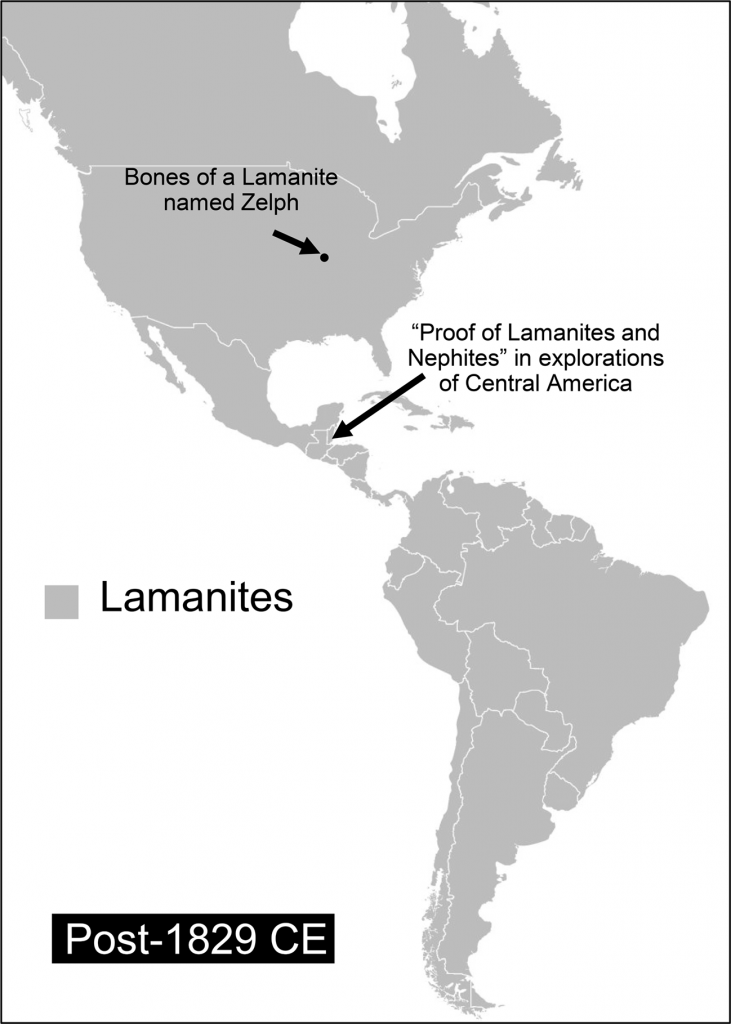
Figure 13. According to Book of Mormon descriptions, bones and ruins across the Americas encountered after 421 ce would be those of the Lamanites
Distances Could Impede Efforts to Validate the Location of Book of Mormon Peoples
The limited geography of the Book of Mormon Promised Land and its unknown location affect all linguistic field studies, archaeological digs, and genetic samplings today that seek to identify scientific evidence of the migrations of the Jaredites, Lehites, or Mulekites. The simple reality [Page 112]is that the research efforts could be hundreds or thousands of miles away from the original Promised Land (Figure 14).
[Page 113]
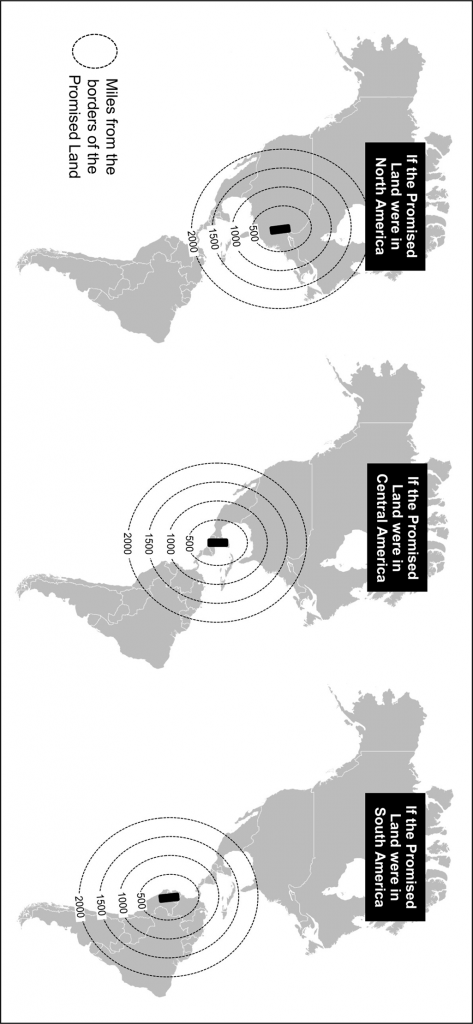
Figure 14. Native American archaeological, genetic, and linguistic data gathered from thousands of miles away from the original Promised Land would be less likely to contain evidence of the Book of Mormon peoples
Anthropological evidence of the Promised Land peoples would undoubtedly have diffused outside of the confines of the original area. Yet, without the horse or other forms of rapid transit to support long-standing consequential exchanges, detecting their impact today on language, DNA, or archeology just a few hundred miles away might be hampered.
Concentrated Native American Losses at the Original Promised Land Location
Researchers seeking to document the existence of the Book of Mormon peoples must confront the possibility that the Promised Land residents experienced devastating losses after 400 ce. Over the past millennia, [Page 114]multiple territories throughout the Americas have experienced localized losses of indigenous inhabitants. Some of these involved areas over 100,000 square miles. If such localities overlapped or encompassed the original Promised Land, significant genetic and linguistic losses of the Book of Mormon populations would have been unavoidable.
700 to 900 ce — Mayan Decline
An example of a localized population loss is the Mayan nation. LIDAR (Light Detection and Ranging) uses laser pulsations to produce high-definition scans that highlight “smaller features covered by dense rainforest canopy.”87 In 2016, scientists used LIDAR to scan more than 800 square miles along the borders of Guatemala and the Yucatan peninsula of Mexico, identifying 61,480 structures. “Extrapolation of this settlement density to the entire 95,000 square kilometers [37,000 square miles] of the central lowlands produces a population range of 7 million to 11 million” during the Late Classic period [600–900 ce].88 These estimates are based on “both on the number of structures revealed by the lidar data and on the estimated amount of land that may have been used for agriculture, taking into consideration the traditional farming practices of the area, average yields, and basic caloric requirements. The estimate is somewhat conservative, falling within a range of others made for this area and time period.”89
Ground explorations support that these numbers could be low. Ben Guarino explains,
For all its power, lidar cannot supplant old-fashioned archaeology. For 8 percent of the survey area, the archaeologists confirmed the lidar data with boots-on-the-ground visits. This “ground truthing” suggests that the lidar analysis was [Page 115]conservative—they found the predicted structures, and then some.90
As a sidebar observation, the buildings identified include “individual defensive features.” According to the primary researchers,
Bridges, ditches, ramparts, stonewalls, and terraces … were constructed as components of “built defensive systems.” These combined with natural defenses to protect “defended areas.” There were five types of built defensive systems: landscape ditch-and-rampart, hilltop ditch-and-rampart, contoured terrace, stand-alone rampart, and stone wall.91
These discoveries are consistent with some of the fortifications described in the Book of Mormon.92
Archaeologists have demonstrated that the Mayan empire extended beyond the “central lowlands,” occupying over 100,000 square miles. Surface expeditions have revealed that most of the buildings and edifices are currently uninhabited and overgrown with local foliage. If, for example, the Promised Land was initially located in this area and then a few centuries after the Nephite extinction the area was devastated and vacated, the primary locus of the Book of Mormon peoples’s genetic and linguistic elements would have been lost (see Figure 15).
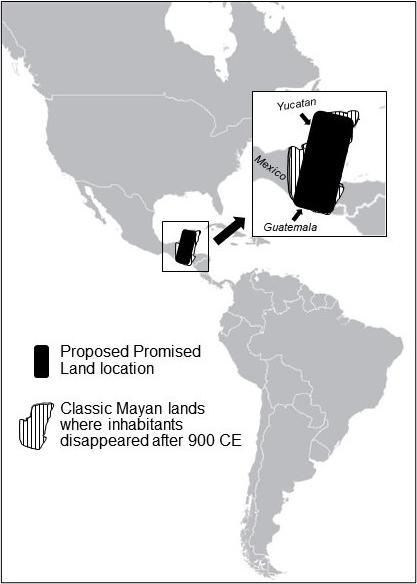
Figure 15. Millions of Mayans in Mesoamerica disappeared by 900 ce. If, for example, the original Promised Land were within this geographic area, the genetic and linguistic focus of its Book of Mormon peoples would have been lost
1492 ce — European Explorers Encounter Millions of Indigenous People
The earliest European adventurers to arrive in the Americas after 1492 ce “encountered a large native population that was distributed over a massive geographical expanse from the Arctic regions of North America through the Amazonian forests of Brazil to the bleak landscape of Tierra del Fuego, South America.”93 Anthropologists have debated for decades the precise number of these Native Americans.94
[Page 116]A variety of scientific methods have been applied to provide accurate estimation, the result ranging 8.4 million to 112 million indigenous Americans.95 A 1997 article, “How Many People Were Here before Columbus,” summarizes:
No one, in fact, knows how many people lived anywhere in those days, except for perhaps a city or two in Europe. The first national censuses occurred centuries later: 1749 in Sweden, 1790 in the fledgling United States, 1801 in France [Page 117]and Britain; it was 1953 when China took a complete count … A recent effort by geographer William Denevan to reconcile the many conflicting estimates, by using the best findings of various scholars, concludes that 54 million people inhabited the Americas in 1492.96
Tzvetan Todorov, author of The Conquest of America, estimated a higher population: “In 1500, the world population is approximately 400 million, of whom 80 million inhabit the Americas. By the middle of the sixteenth century, out of these 80 million, there remain ten” million still living.97
1500 ce — European Diseases Decimate Amerindian Populations
Regardless of the actual population numbers, virtually all scholars agree that upon the arrival of the Europeans in 1492 ce, diseases and armed conflicts ravaged the indigenous inhabitants. “There is little doubt about the massive and rapid drop in that population in the sixteenth century,” writes William Denevan. “The discovery of America was followed by possibly the greatest demographic disaster in the history of the world.”98 Further,
Isolation, such as that of the American Indians from the Old World, rendered populations very susceptible to catastrophic epidemics from diseases introduced from overseas. The major killers included smallpox, measles, whooping cough, chicken pox, bubonic plague, typhus, malaria, diphtheria, amoebic dysentery, influenza, and a variety of helminthic infections.99
George Milner and George Chaplin agree that “the loss of life following the introduction of Old World diseases” among the eastern North American population was “horrific and devastating to native [Page 118]societies.”100 One study reported the Native American population “declined by 87% following European colonization.”101 As British historian Michael H. Crawford further explains,
English settlements may not have been possible [in the Americas] had disease imports not paved the way. Without the effects of smallpox, Francisco Pizarro would probably not have succeeded in his conquest of the Inca Empire of Peru. The first smallpox epidemic started in Vera Cruz, Mexico, during Cortez’ first contact in 1519. This disease spread into Guatemala, and then into what is now northern Peru in 1524–26. The Inca ruler and his entourage, including the only legitimate heir, all contracted smallpox and died. The result of their demise was the division of the Empire between rivals, thus lessening Inca resolve and facilitating the conquest of the Empire.102
How many Amerindians died during the first century after Columbus? The estimates of death percentages range from lows around 75% to a high of 95%.103 Scholars agree that the loss of life during this period was cataclysmic. As William M. Denevan acknowledges, “Despite recent population increases, most Indian cultures have become extinct or nearly so.”104
Post-1600 ce — Continued Indigenous Losses
The early epidemics (circa 1600 ce) that leveled Amerindian populations were just the beginning. Subsequent waves of smallpox and other diseases continued to devastate Native Americans by the thousands. Adam Hodge described the death encountered around 1780:
The mid-nineteenth-century artist George Catlin once observed that smallpox was “the dread destroyer of the Indian race.” Repeated epidemics produced a staggering death toll. Among those epidemics was one that swept the [Page 119]northern Great Plains of North America for eighteen months from 1780 to 1782, killing half or more of the region’s Native population. The Mandans, Hidatsas, and Arikaras, who lived in semisedentary villages on the northern Plains, lost approximately 70 to 80 percent of their populations. The crowded, stationary nature of their large villages led to rapid smallpox diffusion and high human mortality.105
Multiple other endemics and pandemics can be documented throughout North and South America well into the nineteenth century. In examining the epidemic of 1830–1833, it was determined that malaria was the “killer of three-fourths of the Native Americans then inhabiting the Sacramento and the northern San Joaquin valleys and the lower Columbia River banks.”106
These observations illustrate how residents of a limited-sized Promised Land might risk annihilation in the wake of even a single disease outbreak or extended localized armed conflict. Archaeological research supports that such concentrated population losses occurred at multiple locations throughout North and South America, even before the arrival of the Europeans. Their influx also introduced additional waves of total territorial destruction. Obliteration of the original region of Book of Mormon linguistics and genetics would not have completely eliminated their existence from the continents, but it could impede their subsequent detection by geneticists, anthropologists, and archaeologists today.
All Native Americans as a “Remnant of the House of Israel”
A limited Promised Land geography affects expectations regarding the potential relationship of Native Americans today to the original Lamanites. Joseph Smith described the title page of the Book of Mormon as “a literal translation, taken from the very last leaf, on the left hand side of the collection or book of plates.”107 The title page states that the [Page 120]Lamanites “are a remnant of the house of Israel.”108 As discussed above, authentic genealogical ties to the house of Israel would be predicted to be geographically focused in the area of the original location of the Promised Land. Since that location is unknown and since Joseph Smith’s revelations refer to all Native Americans as Lamanites, God seems willing to co-opt all Amerindians into the house of Israel regardless of their locations.109 This grouping assures that those with literal connections receive the promised blessings in the last days.
That the lineage of Israel would be distributed throughout the world was scripturally predicted: “And the Lord shall scatter thee among all people, from the one end of the earth even unto the other” (Deuteronomy 28:64). Nephi, too, foretold this dispersion throughout the word: “It appears that the house of Israel, sooner or later, will be scattered upon all the face of the earth, and also among all nations” (1 Nephi 22:3). It seems that as the tribes of Israel became scattered, they became salt to season the peoples in the areas where they settled (see Matthew 5:13).
The primary covenant blessing promised to the House of Israel in the latter days is that they will be gathered. Christ told the Nephites, “I gather them in from the four quarters of the earth; and then will I fulfil the covenant which the Father hath made unto all the people of the house of Israel” (3 Nephi 16:5). “I shall gather in, from their long dispersion, my people, O house of Israel” (3 Nephi 21:1).
While such promises may suggest that only a particular lineage will be gathered, the Book of Mormon teaches that “God is mindful of every people, whatsoever land they may be in” (Alma 26: 37) and “all are alike unto God” (2 Nephi 26:33). God also promises that he will gather his “lambs” (Isaiah 40:11), his “sheep” (John 10:16; Alma 5:60), and the “elect”: “I will I gather mine elect from the four quarters of the earth, even as many as will believe in me, and hearken unto my voice” (D&C 33:6). None of these analogies specify genealogy.
Likewise, Paul explained, “For not all who are descended from Israel are Israel” (Romans 9:6 NIV). Belief, not lineage, ultimately governs those who are gathered. Jesus Christ “manifesteth himself unto all those who believe in him, by the power of the Holy Ghost; yea, unto every [Page 121]nation, kindred, tongue, and people, working mighty miracles, signs, and wonders, among the children of men according to their faith” (2 Nephi 26:13). Isaiah wrote: “I will gather all nations and tongues; and they shall come, and see my glory” (Isaiah 66:18; emphasis added).
It might be like a shepherd who has a sheep that wanders into the wilderness. When the shepherd searches to find it, he encounters many wild sheep. Rather than focusing only on gathering his own sheep, he invites all the sheep to follow his voice to enjoy his pasture and the subsequent blessings of his constant presence and care.
While some Native Americans today, referred to as Lamanites in modern scripture, may not possess genetic connections to the House of Israel, God’s promises to them are not diminished. Through obedience, they and all nations may join the gathered House of Israel, defined as those who “have loved me and kept my commandments” (D&C 29:12).110 Nothing is lost as Christ offers to gather us “as a hen gathereth her chickens under her wings, if ye will repent and return unto me with full purpose of heart” (3 Nephi 10:6).
Conclusions
Observers who accept the conclusion that the Book of Mormon saga transpired in a limited geographic area — perhaps less than one percent of the Western Hemisphere — can contemplate some of the possible ramifications. First, more than one remnant of the House of Israel might have been led to the Americas without the Book of Mormon prophet-scribes knowing of their existence. Second, evidence of the existence of the Jaredites, Lehites, and Mulekites may be much more difficult to locate than initially thought because researchers might be looking in the wrong places, or the primary concentration of organic evidence may have been lost. Third, only a subset of Native Americans living in an unknown location today would be expected to have genetic or linguistic ties to the Lamanites. From a Book of Mormon standpoint, all other Amerindians have been numbered with those Lamanites due to their presence in the Americas at the time of the restoration (1830s and beyond). And fourth, as missionary work proceeds, direct ties to the original Book of Mormon peoples are less important as salvific blessings are extended to all.
[Author’s Note: I would like to thank Brant Gardner, Ugo Perego, Godfrey Ellis, and the anonymous reviewers for their feedback and excellent suggestions on earlier drafts of this article.]
[Page 122]Appendix: Book of Mormon References to “Horse” or “Horses”
Table 5. References to the horse in the Book of Mormon, with commentary.
| Book of Mormon Reference | Verse | Comments |
|---|---|---|
| 1 Nephi 18:25 | And it came to pass that we did find upon the land of promise, as we journeyed in the wilderness, that there were beasts in the forests of every kind, both the cow and the ox, and the ass and the horse, and the goat and the wild goat, and all manner of wild animals, which were for the use of men. | Wild horses are mentioned along with other wild animals. |
| 2 Nephi 12:7 | Their land also is full of silver and gold, neither is there any end of their treasures; their land is also full of horses, neither is there any end of their chariots. | See Isaiah 2:7. |
| 2 Nephi 15:28 | Whose arrows shall be sharp, and all their bows bent, and their horses’ hoofs shall be counted like flint, and their wheels like a whirlwind, their roaring like a lion. | See Isaiah 5:28. |
| Enos 1:21 | And it came to pass that the people of Nephi did till the land, and raise all manner of grain, and of fruit, and flocks of herds, and flocks of all manner of cattle of every kind, and goats, and wild goats, and also many horses. | Domestication of “many horses” is implied as they were “raised.” |
| Alma 18:9 | And they said unto him: Behold, he is feeding thy horses. Now the king had commanded his servants, previous to the time of the watering of their flocks, that they should prepare his horses and chariots, and conduct him forth to the land of Nephi; for there had been a great feast appointed at the land of Nephi, by the father of Lamoni, who was king over all the land. | One of five associations of horses and chariots. Implied is that they provide transportation for a king. |
| [Page 123]Alma 18:10 | Now when king Lamoni heard that Ammon was preparing his horses and his chariots he was more astonished, because of the faithfulness of Ammon. | Second of five associations of horses and chariots. |
| Alma 18:12 | And it came to pass that when Ammon had made ready the horses and the chariots for the king and his servants. | Third of five associations of horses and chariots. |
| Alma 20:6−7 | Now when Lamoni had heard this he caused that his servants should make ready his horses and his chariots. And he said unto Ammon: Come, I will go with thee down to the land of Middoni. | Fourth of five associations of horses and chariots. Implied is that horses and chariots provide transportation for a king. |
| 3 Nephi 3:22 | … they had taken their horses, and their chariots, and their cattle, and all their flocks, and their herds, and their grain, and all their substance, and did march forth by thousands and by tens of thousands. | Fifth of five associations of horses and chariots. Implied is that the horses may be a source of food. |
| 3 Nephi 4:4 | The Nephites being in one body, and having so great a number, and having reserved for themselves provisions, and horses and cattle, and flocks of every kind, that they might subsist for the space of seven years, in the which time they did hope to destroy the robbers from off the face of the land. | Horses are listed with “provisions,” implying a source of food. |
| 3 Nephi 6:1 | And now it came to pass that the people of the Nephites did all return to their own lands in the twenty and sixth year, every man, with his family, his flocks and his herds, his horses and his cattle, and all things whatsoever did belong unto them. | Horses included with other sources of food. |
| 3 Nephi 21:14 | Yea, wo be unto the Gentiles except they repent; for it shall come to pass in that day, saith the Father, that I will cut off thy horses out of the midst of thee, and I will destroy thy chariots. | Micah 5:10 |
| Ether 9:19 | And they also had horses, and asses, and there were elephants and cureloms and cumoms; all of which were useful unto man, and more especially the elephants and cureloms and cumoms. | A separate civilization mentions horses in the context of named unknown animal species (cureloms and cummons) |



Go here to see the 35 thoughts on ““Unavailable Genetic Evidence, Multiple Simultaneous Promised Lands, and Lamanites by Location? Possible Ramifications of the Book of Mormon Limited Geography Theory”” or to comment on it.